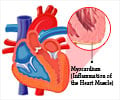A high prevalence of cardiovascular disorders is seen in male breast cancer patients. Lack of cases in male patients warrants more studies to design further cardiovascular care in male cancer patients.

‘A high prevalence of cardiovascular disorders is seen in male breast cancer patients. Lack of cases in male patients warrants more studies to design further cardiovascular care in male cancer patients. This would help design better treatment targets.’





A retrospective chart review evaluation of 24 male breast cancer patients, between 38 and 79 years old, was done at the Georgetown Lombardi Comprehensive Cancer and MedStar Washington Hospital Center in Washington. 42% of the patients were African American, 29% being Caucasian, 4% Hispanic, and 25% of another ethnicity. Family history of breast cancer was noted in almost half of the patients. 79% of the patients had invasive ductal carcinoma (the most common type of breast cancer). In Invasive ductal carcinoma, the onset of tumor growth begins in breast ducts followed by the spread into the surrounding breast tissue.
Most of the patients underwent a mastectomy, while a mix of treatments like chemotherapy, HER2-targeted therapy, radiation, and hormone therapy was also noted. 6 patients were diagnosed with a second primary malignancy and 3 with a third primary malignancy.
Heart Disease in Male Cancer Patients
It was observed that 88% of patients were overweight, 58% had high blood pressure and 54% had high cholesterol. Tachyarrhythmia (abnormally increased heart rate) preexisted in 8% of patients and developed in 13% of patients while undergoing treatment. 2 patients had reduced ejection fraction - decrease in the amount of blood the heart pumps out with each beat while other 2 patients developed heart failure (a chronic condition where the heart doesn't pump blood as well as it should--after treatment).
Advertisement
Even the risk of cardiotoxicity from anthracycline or HER-2 targeted therapy in males is greater than in female breast cancer patients. Hence more studies are needed to warrant evidence in male patients.
Advertisement
Source-Medindia















